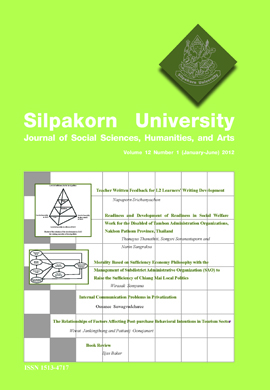Teacher Written Feedback for L2 Learners’ Writing Development
Main Article Content
Abstract
The article focuses on the importance of teacher written feedback on L2 students’ writing development including its effects on both students’ language accuracy and their motivation. It discusses students’ feedback preferences in terms of content, compares the methods of giving feedback, and suggests instructional practices tohelp teachers to provide effective written feedback for their students. Feedback can be given directly or indirectly. In order to give effective written feedback, teachers should consider their students’ needs forerror correction and classroom realities. No matter what method is used,it is important for teachers in ESL and EFL settings to give students acrystal clear explanation. Also, teachers should include comments of praise and encouragement in their written feedback because positive feedback can boost student motivation to improve their writing skills.
Downloads
Article Details
All rights reserved. Apart from citations for the purposes of research, private study, or criticism and review,no part of this publication may be reproduced, stored or transmitted in any other form without prior written permission by the publisher.
References
Brookhart, S. M. (2010) How to Give Effective Feeback to Your Students. Instructional Supervision & Evaluation: The Teaching Process, pp. 10-18.
Chandler, J. (2003) The Efficacy of Various Error Feedback for Improvement in the Accuracy and Fluency of L2 Student Writing. Journal of Second Language Writing. 12: 267-296.
Chi, F. (1999) The Writer, the Teacher, and the Text: Examples from Taiwanese EFL College Students. Paper Presented at the World Congress of Applied Linguistics. Retrieved March 10, 2011, ERIC database.
Cohen, A. D. and Cavalcanti, M. (1990) Feedback on Compositions: Teacher and Student Verbal Reports. In B. Krou (Ed.), Second Language Writing, pp. 155-177. New York: Cambridge University Press.
Ferris, D. R. (2006) Does Error Feedback Help Student Writers? New Evidence on the Short- and Long-term Effects of Written Error Correction. In Hyland, K., & Hyland, F. (Eds.), 81-104.
_________. (1997) The Influence of Teacher Commentary on Student Revision. TESOL Quarterly, 31(2): 315-339.
_________. (2002) Treatment of Error in Second Language Student Writing. Ann Arbour: University of Michigan.
Ferris, D. R. and Roberts, B. (2001) Error Feedback in L2 Writing Classes: How explicit does it need to be?Journal of Second Language Writing, 10: 161-184.
Frantzen, D. (1995) The Effects of Grammar Supplementation on Written Accuracy in an Intermediate Spanish Content Course. Modern Language Journal, 79: 244-329.
Frodesen, J. (2001) Grammar in Writing. In Celce-Murcia, M. (Ed.), Teaching English as a Second or Foreign Language (3rd ed.), pp. 233-248. Boston, MA: Heinle and Heinle. Teacher Written Feedback for L2 16Napaporn Srichanyachon
Hyland, F. (2003) Focusing on form: Student Engagement with Teacher Feedback. System, 31: 217-230.
Hyland, F. and Hyland, K. (2006) Feedback on Second Language Students’ Writing. Lang. Tech., 39: 83-101.
Cambridge: Cambridge University Press.Lalande, J. F. (1982) Reducing Composition Errors: An Experiment.
Modern Language Journal, 66(1): 140-149. Lee. I. (1997) ESL Learners’ Performance in Error Correction in Writing. System, 25(4): 465-477.
Leki, I. (1991) The Preferences of ESL Students for Error Correction in College Level Writing Classes. Foreign Language Annals, 24(3): 203-218.
Miceli, T. (2006) Foreign Language Students’ Perceptions of a Reflective Approach to Text Correction. Flinders University Languages Group Online Review, 3(1): 25-36.
Nicol, D. and Macfarlane-Dick, D. (2006) Formative Assessment and Self-regulated Learning: A Model and Seven Principles of Good Feedback Practice. Studies in Higher Education, 31(2): 199-218.
Rae, A. M. and Cochrane, D. K. (2008) Listening to Students: How to Make Written Assessment Feedback Useful. Active Learning in Higher Education, 9(3): 217-230.
Richards, J. C. and Lockhart, C. (1996) Reflective Teaching in Second Language Classrooms.
Sadler, D. (1983) Evaluation and Improvement of Academic Learning. Journal of Higher Education, 54(1): 60-79.
Saito, H. (1994) Teachers’ Practices and Students’ Preferences for Feedback on Second Language Writing: A Case Study of Adult ESL Learners. TESL Canada Journal, 11: 246-270.
Sträub, R. (1997) Students’ Reactions to Teacher Comments: An Exploratory Study. Research in the Teaching of English, 31(1): 91-119.
Tribble, C. (1996) Writing. Oxford. Silpakorn University Journal of Social Sciences, Humanities and Arts17
Truscott, J. (1996) The Case Against Grammar Correction in L2 Writing Classes. Language Learning, 46: 327-369.
Ur, P. (1996) A Course in Language Teaching Practice and Theory. Cambridge Teacher Training and Development. Cambridge: Cambridge University Press.
Weaver, M. R. (2006) Do Students Value Feedback? Student Perceptions of Tlitors’ Written Responses. Assessment & Evaluation in Higher Education, 31: 379-394.
Zhang, S. (1995) Reexamining the Affective Advantage of Peer Feedback in the ESL Writing Class. Journal of Second Language Writing, 4(3): 209-222.


